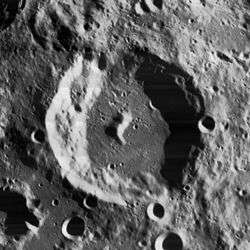Bettinus (crater)
Bettinus is a lunar impact crater located near the southwest limb. Due to its location, the crater has a distinctly oval shape because of foreshortening. To the south of the rim is the similar-sized crater Kircher, and to the northwest is the slightly smaller Zucchius. From the west to the southwest, closer to the limb, is the giant formation Bailly.
 | |
| Coordinates | 63.40°S 45.16°W |
|---|---|
| Diameter | 72 km |
| Depth | 3.8 km |
| Colongitude | 45° at sunrise |
| Eponym | Mario Bettinus |
The rim of Bettinus is only somewhat worn, with an inner wall that is wider to the northwest. The interior floor is relatively flat, with a central rise that is offset to the west of the midpoint. There is a small crater along the eastern rim.
Bettinus lies due south of the Schiller-Zucchius Basin.
Satellite craters
By convention these features are identified on lunar maps by placing the letter on the side of the crater midpoint that is closest to Bettinus.
| Bettinus | Coordinates | Diameter, km |
|---|---|---|
| A | 64.88°S 49.03°W | 26 |
| B | 63.54°S 51.31°W | 25 |
| C | 63.33°S 38.09°W | 23 |
| D | 65.00°S 46.61°W | 10 |
| E | 63.21°S 42.38°W | 8 |
| F | 62.97°S 44.02°W | 7 |
| G | 61.60°S 44.74°W | 6 |
| H | 64.62°S 43.82°W | 8 |
References
- Andersson, L. E.; Whitaker, E. A. (1982). NASA Catalogue of Lunar Nomenclature. NASA RP-1097.CS1 maint: ref=harv (link)
- Blue, Jennifer (July 25, 2007). "Gazetteer of Planetary Nomenclature". USGS. Retrieved 2014-12-17.CS1 maint: ref=harv (link)
- Bussey, B.; Spudis, P. (2004). The Clementine Atlas of the Moon. New York: Cambridge University Press. ISBN 978-0-521-81528-4.CS1 maint: ref=harv (link)
- Cocks, Elijah E.; Cocks, Josiah C. (1995). Who's Who on the Moon: A Biographical Dictionary of Lunar Nomenclature. Tudor Publishers. ISBN 978-0-936389-27-1.CS1 maint: ref=harv (link)
- McDowell, Jonathan (July 15, 2007). "Lunar Nomenclature". Jonathan's Space Report. Retrieved 2007-10-24.CS1 maint: ref=harv (link)
- Menzel, D. H.; Minnaert, M.; Levin, B.; Dollfus, A.; Bell, B. (1971). "Report on Lunar Nomenclature by the Working Group of Commission 17 of the IAU". Space Science Reviews. 12 (2): 136–186. Bibcode:1971SSRv...12..136M. doi:10.1007/BF00171763.CS1 maint: ref=harv (link)
- Moore, Patrick (2001). On the Moon. Sterling Publishing Co. ISBN 978-0-304-35469-6.CS1 maint: ref=harv (link)
- Price, Fred W. (1988). The Moon Observer's Handbook. Cambridge University Press. ISBN 978-0-521-33500-3.CS1 maint: ref=harv (link)
- Rükl, Antonín (1990). Atlas of the Moon. Kalmbach Books. ISBN 978-0-913135-17-4.CS1 maint: ref=harv (link)
- Webb, Rev. T. W. (1962). Celestial Objects for Common Telescopes (6th revised ed.). Dover. ISBN 978-0-486-20917-3.CS1 maint: ref=harv (link)
- Whitaker, Ewen A. (2003). Mapping and Naming the Moon. Cambridge University Press. ISBN 978-0-521-54414-6.CS1 maint: ref=harv (link)
- Wlasuk, Peter T. (2000). Observing the Moon. Springer. ISBN 978-1-85233-193-1.CS1 maint: ref=harv (link)
